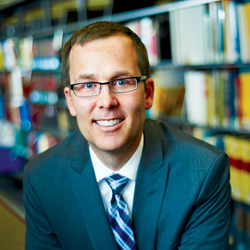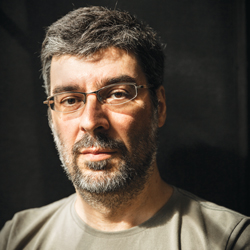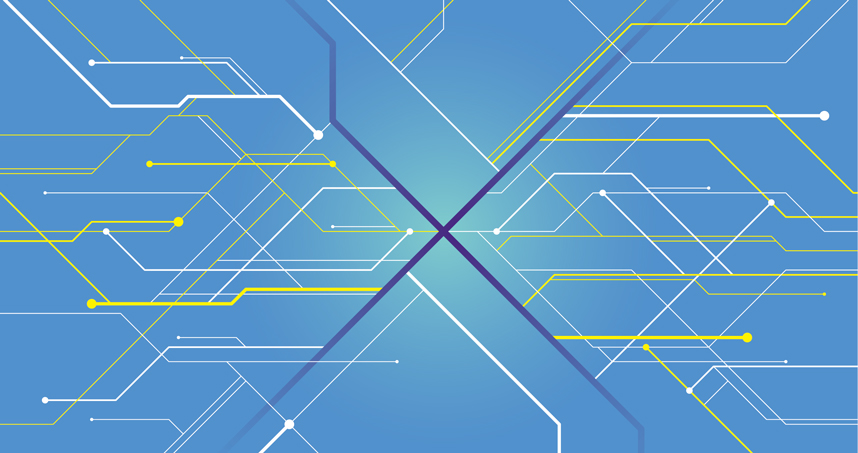Where Tech Crosses Paths With the Law
Northwestern's schools of engineering and law join forces to refine and preserve the rule of law worldwide.
Though judges and juries strive to be impartial, a deep look at macro-level patterns found in data calls into question whether this is actually the case.
Take the death penalty, for example. Only after researchers began to study who was sentenced to death rather than to life in prison did patterns related to ethnicity emerge. A 1990 US General Accounting Office report combined 28 different studies of homicide cases to find that, among defendants with similar criminal histories, those whose victims were white were several times more likely to receive the death penalty than those whose victims were African American.
Nearly 30 years later, advances in artificial intelligence (AI) and machine learning enhance our ability to understand other important insights in legal proceedings previously hidden in large datasets. These tools give rise to many other opportunities—and challenges.
On one hand, software can help lawyers prepare for litigation. On the other, it might give them an unfavorable advantage.
If attorneys can identify a pattern of words or terms in documents that can be used to guide judges to rule in their favor, should they be able to use them? Because these tools are so new, should legislation govern their use? How can lawyers and engineers work together to make these tools not only useful but also fair by design?
These are the questions Northwestern Engineering and Northwestern Pritzker School of Law faculty and students hope to answer through new courses, research projects, and joint initiatives at the intersection of technology and law to help shape the future of legal services, judicial systems, and the law itself.
“We want interdisciplinary teams both to create new tools and to understand how the other side thinks and works,” says Julio M. Ottino, dean of the McCormick School of Engineering. “With that understanding comes a new way of collaborating that will lead not only to innovation but also to leadership in artificial intelligence and the law. It’s a space that’s primed for guiding principles.”
“We want interdisciplinary teams both to create new tools and to understand how the other side thinks and works. With that understanding comes a new way of collaborating that will lead not only to innovation but also to leadership in artificial intelligence and the law. It’s a space that’s primed for guiding principles.”
Those working in law must understand AI technologies to help regulate and use them to make legal systems more efficient and fair, says Kimberly Yuracko, dean of Northwestern Law.
“We want to leverage these technologies to create the kind of society we want to live in. Together we can use technology to better realize our foundational principles of justice.”
Forging New Law and Tech Partnerships
Both computer science and law faculty approach this partnership with caution because of the widespread use of AI systems in media for the dissemination of “fake news.” As algorithms play a heavy hand in offerings to readers, false information can be presented to reinforce a reader’s point of view.
“Now we have news filter bubbles and weaponization of information,” says Kris Hammond, Bill and Cathy Osborn Professor of Computer Science. “Unless someone is at the wheel, bad things like this can happen. But if the right people are making decisions, these advanced technologies can be magnificent.”
“We can collaborate to create law and technologies that promote human rights and expand and preserve the rule of law around the globe.”

This fall, Northwestern Engineering and Northwestern Law enhanced their collaboration by appointing Dan Linna as the director of law and technology initiatives, the first joint position in law and engineering. With his background as an IT consultant and as an attorney representing international corporations and technology clients, Linna has experience on both sides of the equation. At Michigan State University, he founded LegalRnD–the Center for Legal Services Innovation. At Northwestern, he aims to work with faculty and teach students at both the law and engineering schools to improve legal services and determine the best path for regulation of emerging technologies.
“Technology is already changing the delivery of legal services,” he says. For example, some legal search services use natural language processing and semantic analysis in their retrieval processes, while others provide text analytics and machine learning to support the discovery process. Emerging products include AI software that can learn from the decision history of a court or judge to predict outcomes or provide insights into the opposing counsel.
“We want to work with big law firms, legal aid groups, and within the legal ecosystem overall to improve access to the law and help improve legal systems,” he says. Also, lawyers could help lead how AI regulations are structured. “We want to be proactive, and ask how law and regulation can facilitate innovation that seizes opportunities to improve society for everyone.”
Engineering and Law Students Working Together
Linna teaches at both Northwestern Law and Northwestern Engineering. In law, he teaches Artificial Intelligence and Legal Reasoning, helping to demystify the technology and motivate students to consider how to use data and technology to improve the delivery of legal services. In engineering, he instructs Master of Science in Artificial Intelligence students about law and the governance of AI. “I want computer scientists not only to understand regulation, but also to shape it and create an environment where these tools will be used for good,” he says.
This past winter and spring, students from both schools came together in CS+X Innovation Lab: Building Technologies for the Law. Thirty-two engineering and law students were divided into six teams and charged with designing, developing, and testing innovative products in the legal space. The course was taught by Linna, Hammond, and Dave Schwartz, Stanford Clinton Sr. and Zylpha Kilbride Clinton Research Professor of Law.
“We wanted to teach law and computer science students to work together,” Hammond says. “We wanted to develop a real partnership to solve these problems. The results were breathtakingly successful.”
One team developed a system that uses AI to check a set of clauses in a contract during negotiation in a fraction of the time an associate normally takes to complete. “Humans are still involved in the process—this just takes one part of the problem off somebody’s plate,” Hammond says.
Another group developed an application related to telemedicine, where doctors provide consultations remotely. While this technology provides quick and easy diagnoses, it raises legal questions for doctors, in-house counsel, and insurers. The team’s application allows these stakeholders to ensure a doctor is compliant in providing telemedical care in any of the 50 states by answering a series of questions.
Creating Systems Guided by Democratic Principles
Initiatives like these will help lead the way to a future that isn’t mired in the legal equivalent of “fake news.”
“We can build a road to a future where the use of these technologies aligns with the goals and values of the law: fairness, transparency, responsibility, culpability, and liability,” Hammond says. “If we’re going to use these technologies well and correctly, we have to have this convergence.”
That will help both those in the legal system and those who find themselves caught within it. “What if we were proactive and created a world where the law was embedded in systems to respect human rights and democratic principles from the beginning by design?” Linna says.
“We can collaborate to create law and technologies that promote human rights and expand and preserve the rule of law around the globe.”
Finding a Better Way to Study Federal Court Records
Northwestern researchers and students have launched a cross-disciplinary pilot project that could put the University at the forefront of enabling artificially intelligent access to federal court records. Accessing those records through the current online PACER (Public Access to Court Electronic Records) system is onerous. Not only is the interface not intuitive, but the federal government charges 10 cents per page downloaded.
For researchers who want to look for patterns among the records, that’s no small fee. In 2018 alone, the federal court system handled approximately 300,000 new civil cases and 75,000 criminal cases generating millions of content pages.
 “It makes no sense,” says Luís Amaral, Erastus Otis Haven Professor of Chemical and Biological Engineering at Northwestern Engineering. One of Amaral’s specialties is finding new patterns among large data sets. So when he heard Dave Schwartz, Stanford Clinton Sr. and Zylpha Kilbride Clinton Research Professor of Law at Northwestern Pritzker School of Law, give a presentation about this problem, Amaral started thinking about solutions.
“It makes no sense,” says Luís Amaral, Erastus Otis Haven Professor of Chemical and Biological Engineering at Northwestern Engineering. One of Amaral’s specialties is finding new patterns among large data sets. So when he heard Dave Schwartz, Stanford Clinton Sr. and Zylpha Kilbride Clinton Research Professor of Law at Northwestern Pritzker School of Law, give a presentation about this problem, Amaral started thinking about solutions.
“If we can’t see or measure what’s happening in the judicial system, how can we know what’s going well, or what needs improvement?” he says. Amaral, who also codirects the Northwestern Institute on Complex Systems, got together with a group of computer science and law school faculty members to consider the problem.
What made most sense was to download all the federal court records and create their own open and searchable database. A great idea, but such an endeavor could cost $100 million. Problem solvers by trade, the group members found that if they downloaded only the table of contents for each case, they would have enough information about the judge, attorneys, litigants, and cases to create a useful database.
Increasing Openness and Fairness
The group launched the Northwestern Open Access to Court Records Initiative to prove the concept. The first step was to download information from all federal civil and criminal lawsuits brought in the years 2010 and 2015 for the US District Court for the Northern District of Illinois (covering Chicago) and the Northern District of Georgia (covering Atlanta). They also downloaded biographical information on all active judges in the two districts and identified all publicly traded corporations named in a case.
Last winter quarter, as part of the initiative, a group of students in CS+X Innovation Lab: Building Technologies for the Law, was charged with creating a pilot system through which potential users could ask questions like: How does the ethnicity of judges correlate with their caseloads? Does litigation involving large publicly traded companies differ from other litigation in terms of duration, litigation intensity, settlement rates, and case outcomes? Does litigation involving minority-owned companies differ from other litigation?
“We hope to create an ecosystem of applications and tools that will enable reporters, lawyers, economists, political scientists, and the public to study this system. The courts system should be a paragon of openness and transparency. This system will help with that.”
“It’s a fundamental artificial intelligence and computer science problem,” says Kris Hammond, Bill and Cathy Osborn Professor of Computer Science. “How do you give people access to complex analytics when they don’t know how to describe exactly what they need? The answer—by employing natural language to drive search and analytics.”
The pilot was so successful that the initiative received funding from the National Science Foundation. The Northwestern team is working with Solstice, a Chicago-based digital strategy and user experience firm, to design and deploy the first version of this system.
“We hope to create an ecosystem of applications and tools that will enable reporters, lawyers, economists, political scientists, and the public to study this system,” Amaral says. “The courts system should be a paragon of openness and transparency. This system will help with that.”

